By Dr Fuad Ali
As the Omnibus study has unfolded, our team has been keen to design measures that help us understand the relationships between inequality and learning gain, and how these might express themselves, directly and indirectly, through the metrics that we use and through institutional data. With more students than ever entering HE from non-traditional (HE)ritage, more of them working to maintain themselves at the time of study and the forthcoming challenges of enabling lifelong learning in a changing job market, HE institutions and the programmes that they deliver will be increasingly required to adapt to their students’ life worlds’ and terms in order to bring the best out of them. One point of entry into this dynamic space is through our data on how students report spending their time.
Student Viscosity

Figure 1
The previous blog post on learning gain introduced the idea of a Student Viscosity Model (SVM), to account for multiple challenges many students face, outside their HEI participation, that shapes their engagement with it. The ‘viscosity’ referred to here is structural in nature but negotiable to a degree. The metaphor I like to use here is of the fish swimming upstream (Figure 1), encountering specific and dynamic pressures according to their individual situations journeys and efforts. SVM differs from the contextual value add trailed briefly, if clumsily, then dropped from the schools sector, in its individual student-centricity.
A basic model for SVM can be developed by summing the time spent working for pay, providing care for dependents and commuting to campus, as self-reported on the UKES subscales of the Wave 2 survey administered in Spring 2017. It is important to note here however that these variables are not necessarily independent, as commuting times may include the school run and commutes to work. It is as first order estimates, of “life stretch”, that they are valuable.
The variability of SVM distributions between participating institutions, Gender, broad Ethnicity Groups and Age Range is plotted on Figures 2, 3, 4 and 5 below. To summarise, participating UELs’ students’ negotiate higher viscosities than Roehampton and Brunel’s. Female students face more demands on their time than their male peers. Black student groups face higher viscosity than Asian students, than White students, a well-known structural inequality. Somewhat intuitively, viscosity distributions for the four age ranges are progressively less skewed.
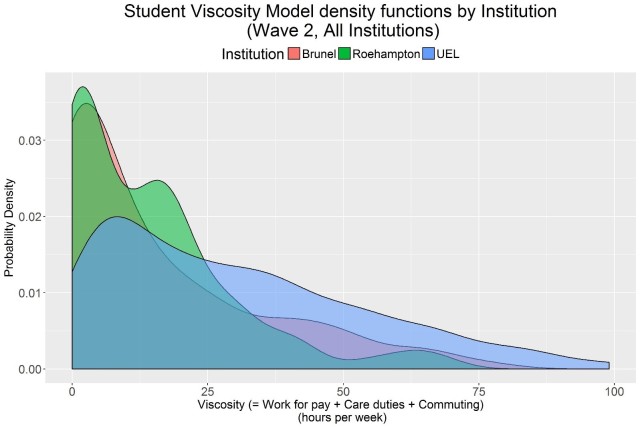
Figure 2
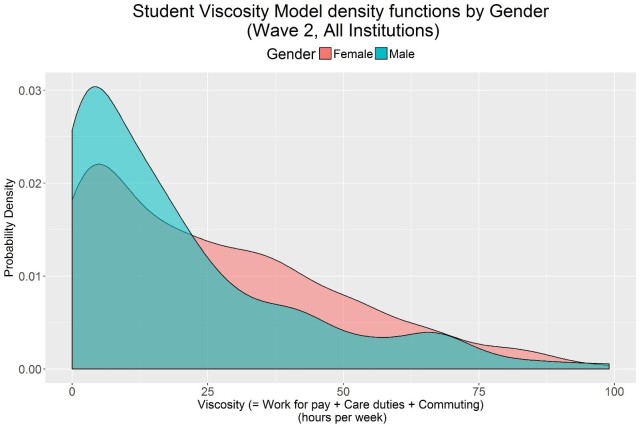
Figure 3
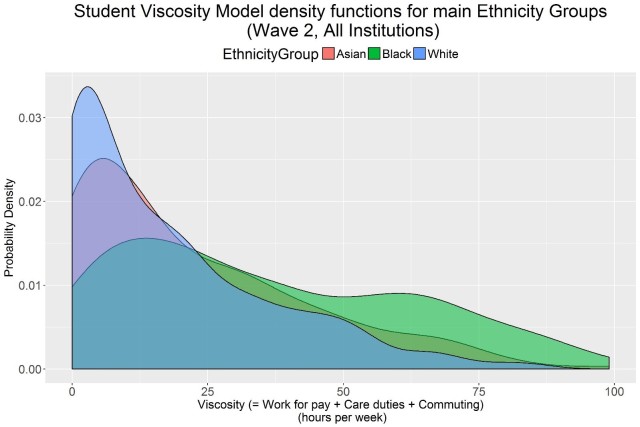
Figure 4
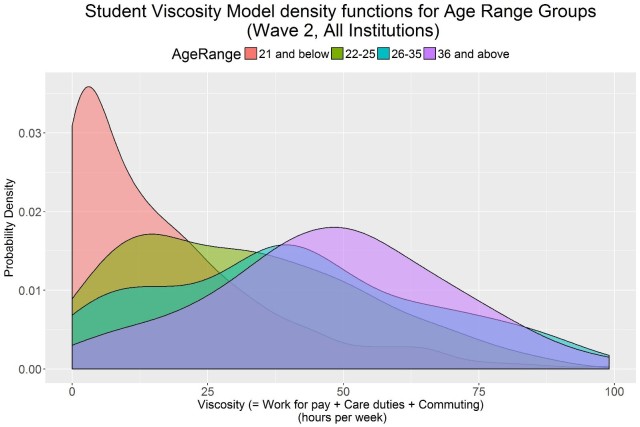
Figure 5
Connecting with UEL attainment data, plotting SVM by marks attained on Figure 6 below suggests a modest negative correlation, and multiple linear regression analysis alongside socio-demographic dimensions of ethnicity group, gender and age group confirms viscosity as a variable of marginal significance to scored attainment. Given the predictive predilection of learning analytics in HE at the present moment, SVM may not have the perceived performance influencing heft of socio-demographic data, but from a Teaching and Learning support point of view there is an opportunity here to mould provision to everyday conditions not just when they become extenuating.
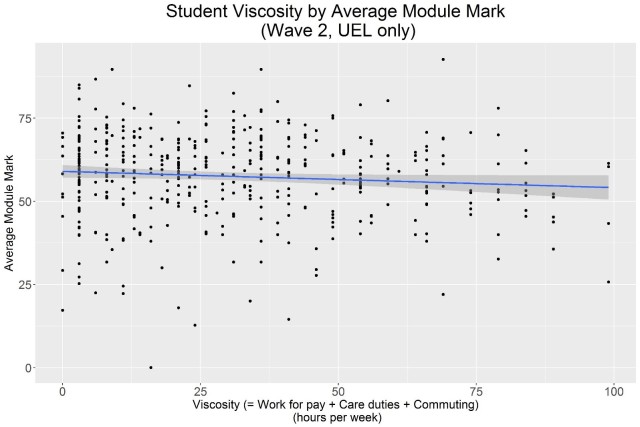
Figure 6
Correlations between marks and individual UKES item scores were also educative, multiple linear regression analysis shows that time spent on individual study had a significant and positive correlation with module marks, but somewhat counter-intuitively, time spent on volunteering outside the HEI context and commuting had negative impacts.
Struggling to register the benefits of volunteering
Extra-curricular university activity and volunteering were also observed to have markedly negative impacts on Academic Behaviour Confidence Gain amongst our first year heavy cohort. Evidence of positive impacts of voluntary work on the UKES personal development subscale is challenging at this stage, as time spent on individual study is ubiquitous in its impact, be that on Being innovative and creative, acquiring employability skills or developing or clarifying personal values or ethics. Revisiting the time spent and personal development subscales in the Wave 4 data, which will be spread along more levels of study will help us understand this further, and whether benefits of voluntary commitments accrue with time or correlate with motivational values.
The question of voluntarism is interesting, not just because self-identified volunteering levels are relatively low, but for the inequality of the conditions for volunteering. In our data for last year across three institutions the, level of a student’s voluntary activity is significantly and negatively correlated to student viscosity and student study toil. Also in last year’s data, voluntary activities were not significantly correlated with the personal development indices deployed or academic behaviour confidence scores. Therefore given the data, should our most responsible advice, at least to first year students, be to just focus on their studies?
Commutancy and inequality reproduction
Recent research by Kingston University as explored the impacts of commuting on student performance and the learning support opportunities of commuting. Further analysis of commuting times in the Omnibus data shows how BAME groups and older age groups travelled on average longer weekly commutes than younger age groups and their white student peers. This ‘commutancy’ gap, when taken together with our institutional range of partners, says something quite important about the appeal of the specific university for specific genres of student, but is itself outscaled by that more sociogenetic (Fanon) Black-White attainment gap, whose strength was on the order of tens of hours of weekly commuting. The question that I have following this, is whether commutancy is additive and reproductive of existing inequality and what creative adjustments could be made at the institutional and sector level to prevent such institutional amplification of inequality.

